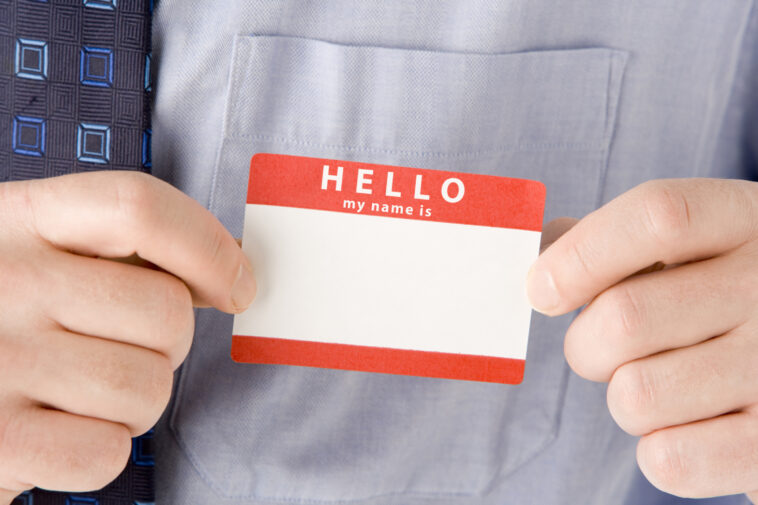Understanding the importance of name tags is fundamental. Primarily, they serve as identifiers in various gatherings – be it a conference, networking event, corporate meeting, or social occasion. They do more than just reveal names; they provide context. These tags instantly tell us about a person’s role and affiliation, making introductions smoother and conversations easier to initiate.
Name tags play a significant role in breaking the ice, especially in settings where individuals may not know each other. They eliminate the awkwardness of forgetting names, fostering a comfortable environment for interaction. On a deeper level, the tags encourage a sense of community and belonging within a group, promoting mutual respect and understanding among diverse participants.
Choosing the Right Name Tag
Choosing the right name tag might seem trivial, but it’s an aspect worth considering. Different types of tags, such as adhesive, magnetic, or clip-on, have their unique attributes and appropriateness depending on the occasion. For instance, while adhesive ones are good for one-time use, magnetic or clip-on types are perfect for regular events as they are more durable and comfortable to wear.
The design of the name tag can greatly affect its visibility and readability. The font size should be large enough to be read from a reasonable distance, and the contrast between the text and background color should be high. The material of the tag also matters; it should withstand the duration of the event without causing discomfort to the wearer.
Proper Placement

Where should you wear a name tag? The answer might be more important than you think. Generally, the right side of the chest is the preferred spot for name tag placement. This is due to the natural line of sight that follows when shaking hands – the American style of greeting. However, it’s also important to be aware of cultural or regional variations in name tag etiquette.
For example, in certain cultures, the left side might be more appropriate as it is closer to the heart, symbolizing sincerity and trust. Therefore, being cognizant of these nuances can lead to more effective communication and mutual respect among participants in any gathering.
Design and Content
Designing name tags extends beyond aesthetic considerations. It’s crucial to think about what details to include. Generally, a name tag should carry essential information such as full name, job title, and the company or organization represented. However, ensure that you’re not overcrowding the tag – it needs to be easy to read at a glance.
Consider personalization to make your name tags more engaging. For example, include a fun fact about the wearer, use different colors to denote various roles, or use creative typography to enhance legibility and memorability. Remember, the goal is to foster connections, so your design should encourage and facilitate conversation.
Dress Code and Name Tags
As a part of your attire, name tags should align with the event’s dress code. Whether it’s a formal corporate event, a casual team-building outing, or a themed party, your name tag shouldn’t feel out of place. For formal events, go for sleek, simple designs that maintain a professional image. In contrast, casual or themed gatherings offer a little more room for creative flair.
It’s also vital to consider the placement and method of attachment to avoid damaging delicate fabrics or disrupting the aesthetics of the outfit. Always aim for a balance between functionality, comfort, and style.
Networking

In networking situations, name tags become a powerful tool. They serve as visual aids for recalling names, which is key for building new connections. They can also act as conversation starters, offering snippets of information about someone’s professional life that might spark shared interests.
In using these tags for networking, remember to glance discreetly. While it’s accepted that you might need a little help recalling someone’s name, it’s less acceptable to let your gaze linger too long on their chest. Maintain good eye contact for a more genuine interaction.
Avoiding Common Name Tag Mistakes
Even with name tags, things can go awry. Common mistakes include placing the tag too high or too low, overcrowding with information, or selecting a design that’s difficult to read. Another common error is forgetting to remove the tag after the event, which can be embarrassing in public places.
A simple solution to avoid these faux pas is to follow the etiquette tips discussed earlier. Also, be sure to do a quick check before and after the event to ensure your name tag is in the right place and that you remember to remove it afterwards.
Respect for Pronouns
In today’s diverse and inclusive world, it’s becoming increasingly important to respect individuals’ preferred gender pronouns. Name tags offer a simple and effective way to share this information. Including pronouns (e.g., he/him, she/her, they/them) on the tags is a sign of respect for people’s identities and an affirmation of an inclusive event culture.
However, it’s essential to ask for people’s preferred pronouns during the registration process rather than assuming based on their names or appearances. This approach ensures that everyone feels seen and respected.
Removal Etiquette
When to remove your name tag can sometimes be a gray area. As a rule of thumb, if you’re still in the event or a place with many attendees present, it’s best to keep the name tag on. It can be particularly useful during networking sessions or large conferences.
However, once you leave the event premises or are in a setting where the tag is no longer relevant (like an after-party at a different venue), it’s acceptable, even recommended, to take it off. This way, you avoid any awkwardness that could come from having it on in unrelated contexts.
Name Tags in Virtual and Hybrid Events

In the era of digital meetings and virtual conferences, virtual tags have gained significance. These can be in the form of display names on video conference platforms or digital badges in virtual event platforms.
Ensure your name is displayed correctly, and consider adding your pronouns or job title if the platform allows. In hybrid events, maintain consistency between your physical and virtual tags for a seamless experience.
Bottom Line
Name tags, despite their simplicity, hold great potential in fostering communication and enhancing the event experience. As with any tool, their power lies in how effectively we use them.




